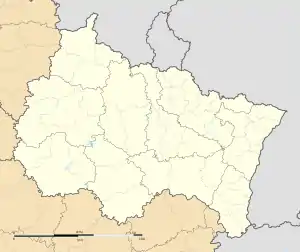Bayonville
Bayonville is a commune in the Ardennes department in the Grand Est region of northern France.[2]
Bayonville | |
|---|---|
 Bayonville village | |
Location of Bayonville 
| |
 Bayonville  Bayonville | |
| Coordinates: 49°23′48″N 5°00′23″E | |
| Country | France |
| Region | Grand Est |
| Department | Ardennes |
| Arrondissement | Vouziers |
| Canton | Vouziers |
| Intercommunality | Argonne Ardennaise |
| Government | |
| • Mayor (2020–2026) | Philippe Etienne |
| Area 1 | 16.19 km2 (6.25 sq mi) |
| Population (2017-01-01)[1] | 99 |
| • Density | 6.1/km2 (16/sq mi) |
| Time zone | UTC+01:00 (CET) |
| • Summer (DST) | UTC+02:00 (CEST) |
| INSEE/Postal code | 08052 /08240 |
| Elevation | 181–305 m (594–1,001 ft) (avg. 245 m or 804 ft) |
| 1 French Land Register data, which excludes lakes, ponds, glaciers > 1 km2 (0.386 sq mi or 247 acres) and river estuaries. | |
The inhabitants of the commune are known as Bayonvillois or Bayonvilloises.[3]
Geography
Bayonville is located some 40 km south by south-east of Charleville-Mézières and 15 km south-west of Stenay. Access to the commune is by the D12 road from Buzancy in the north-west which passes through the centre of the commune and the village and continues south-east to Bantheville - changing to the D15 at the departmental border. Another D15 comes from Tailly in the north-east and goes south through the commune and the village continuing to Imécourt in the south-west. The D55 goes south from the village to Landres-et-Saint-Georges. Apart from the village there are the hamlets of Chennery and Landreville. The commune is mostly farmland with some forest in the east and north.[4][5]
The Agron river flows through the south-east of the commune from north-east to south-west where it continues a meandering path to join the Aire south-west of Saint-Juvin. The Ruisseau du Wassieux flows south-west through the commune and continues south-west to join the Agron near Imécourt. The Furba rises in the north-east of the commune and flows south-west to join the Agron at Landreville.[4][5]
Toponymy
Bayonville was attested in the Latinised form Baionis villa in 960. The derivation is undoubtedly from the "Domain of Baio", a Germanic personal name (cf. Bayonvillers)
Bayonville appears as Bayonville on the 1750 Cassini Map[6] and the same on the 1790 version.[7]
History
In 1828 the communes of Chennery and Landreville were merged with the commune of Bayonville. In 1864 Landreville had 80 inhabitants.
Administration
| From | To | Name | Party | Position |
|---|---|---|---|---|
| 1995 | 2020 | Philippe Etienne |
(Not all data is known)
Demography
In 2017 the commune had 99 inhabitants.
|
| ||||||||||||||||||||||||||||||||||||||||||||||||||||||||||||||||||||||||||||||||||||||||||||||||||||||||||||
| Source: EHESS[9] and INSEE[10] | |||||||||||||||||||||||||||||||||||||||||||||||||||||||||||||||||||||||||||||||||||||||||||||||||||||||||||||
Culture and heritage
_France.jpg.webp)
_France.jpg.webp)
_France.jpg.webp)
Civil heritage
Religious heritage

- Bayonville Church
Notable people linked to the commune
- Claude-François de Maillard first Marquis of Landreville in 1760
See also
References
- "Populations légales 2017". INSEE. Retrieved 6 January 2020.
- Bayonville on Lion1906
- Inhabitants of Ardennes (in French)
- Bayonville on Google Maps
- Bayonville on the Géoportail from National Geographic Institute (IGN) website (in French)
- Bayonville on the 1750 Cassini Map
- Bayonville on the 1790 Cassini Map
- List of Mayors of France (in French)
- Données Cassini, EHESS
- Population en historique depuis 1968, INSEE
- Ministry of Culture, Mérimée PA08000001 Chateau of Landreville (in French)
- Ministry of Culture, Palissy PM08000685 Interior Decor (in French)
| Wikimedia Commons has media related to Bayonville. |
